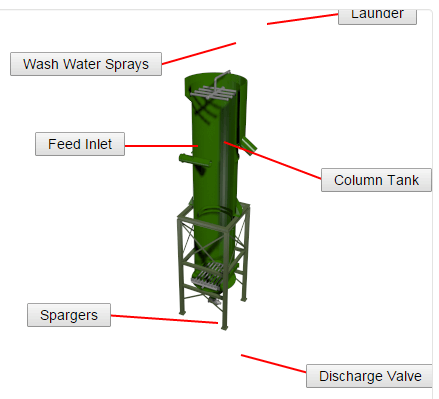 Flotation cells can be divided in two groups: mechanical and pneumatic machines. The first group comprises the traditional cells which employ a mechanical agitation, and the second group is related to pneumatic cells which do not have mechanical devices for maintaining the slurry under agitation. Columns offer the advantages of counter current contact between slurry and air, no requirement for mechanical agitation, and lower power and maintenance costs and greater metallurgical performance. Higher concentrate grades are the main characteristic because good concentrates mean lower drying and transport costs, and fewer penalties due the presence of few unwanted minerals.
Flotation cells can be divided in two groups: mechanical and pneumatic machines. The first group comprises the traditional cells which employ a mechanical agitation, and the second group is related to pneumatic cells which do not have mechanical devices for maintaining the slurry under agitation. Columns offer the advantages of counter current contact between slurry and air, no requirement for mechanical agitation, and lower power and maintenance costs and greater metallurgical performance. Higher concentrate grades are the main characteristic because good concentrates mean lower drying and transport costs, and fewer penalties due the presence of few unwanted minerals.
A column presents three zones: collection, transition, and cleaning. In the first is mixed the fresh feed and the bubbles. The second zone is separation zone between slurry and froth. And the third zone consists of mineralized froth which transports the concentrate which overflows at the top of the column. The slurry is fed almost in the middle of the column and the tailings are discharge at the bottom. The air is added above the tailings exit port by using a diffuser or sparger. Aspirated air allows good control of bubble size and involves less maintenance because bubbles are generated without special devices. Wash water to clean the froth is added through pipes or a shower system in the froth column.
One of the main conditions needed for column flotation is a positive bias. It means that tailings flow is major than feed flow in order to produce counter current flow. This characteristic improves grade and recovery. Other important factor is the slurry level that is maintained by changing wash water addition. Lowering slurry level increases froth column depth and reduces residence time in the recovery zone.
Column cells have been exclusively used in cleaner circuits where a single column replaces several mechanical cells or more than one cleaning stage (e.g. molybdenum cleaning circuit). The superior cleaning performance is due to the action of the wash water. It is believed that washing takes place in a thin layer just above the liquid level which in a column is relatively quiescent giving almost perfect counter current flow of clean of rising particles laden bubbles against a falling stream of clean water. In conventional cells, the liquid surface is quite mobile consequently the wash water goes directly to the slurry reducing the cleaning effect.
Nowadays, column cells are very used in flotation plants of polymetallic ores and exists the trend of employing them in the treatment of precious metals and carbon. Interest in the commercial application of column flotation has led to a need for scale up and design procedures which can be applied to this machine. Operative parameters change greatly from one installation to another. Some researches have used tracers in order to find out how a column works and the results have been used to improve its design and performance. Many applications of column flotation operate at high levels of solids loading in the froth; for instance, this is often the case for column cleaning of fine particles. Under these conditions the performance of the froth zone can strongly affect the unit capacity and the separation efficiency.
